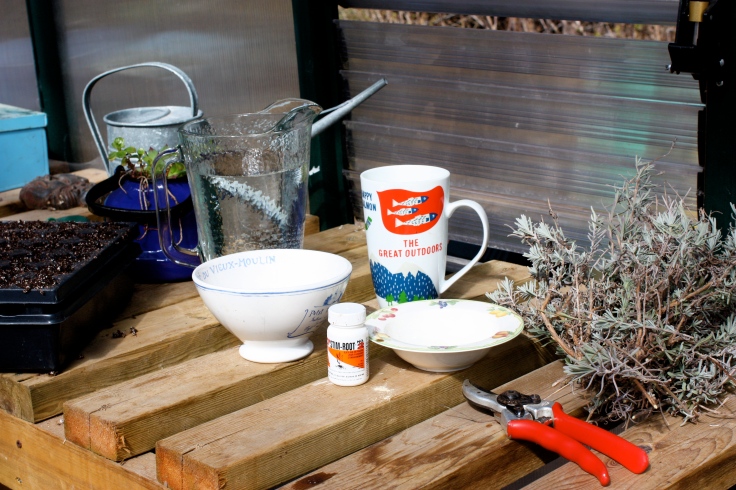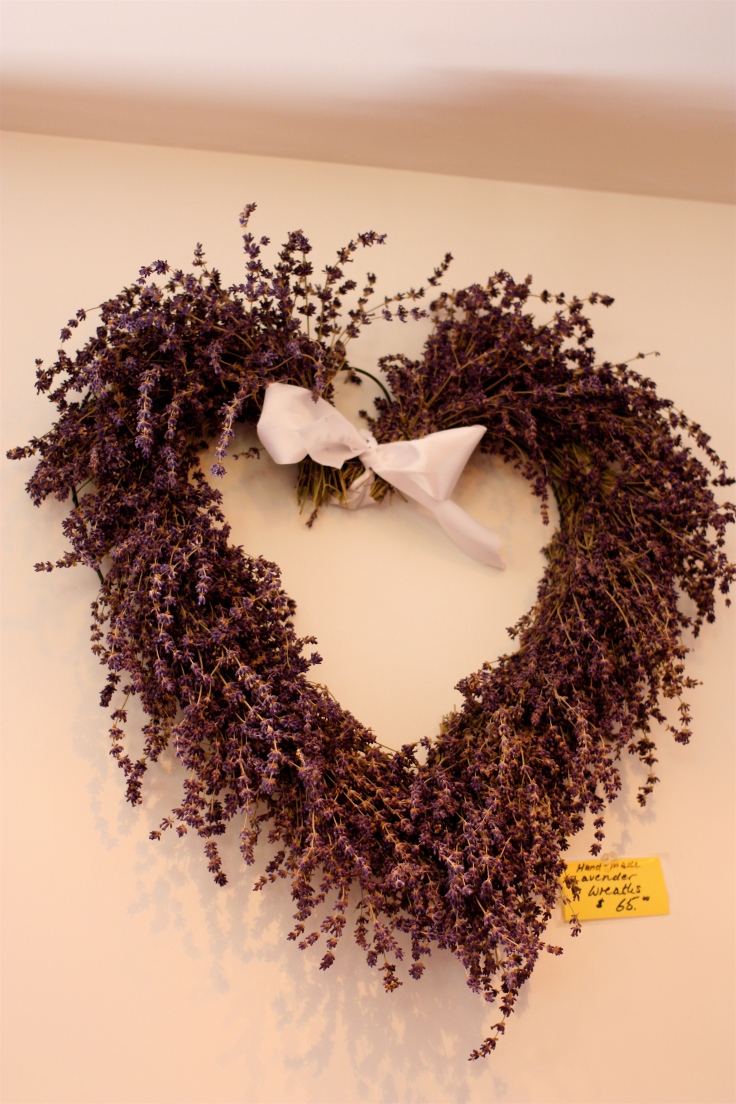
Lavender is one of my favourite garden perennials and it suits our hot dry Okanagan summers perfectly. I have a bank behind the house I want to plant up all in lavender which could cost several hundred dollars if were to buy them as plants from a nursery. I gave growing lavender from seed a go last year in the greenhouse with marginal success. It’s hard to germinate although I did get a few nice white lavenders to grow. I’ve since learned that it’s easier and much more successful to propagate lavender from soft-wood cuttings in the spring. This method clones the lavender so what you see (parent plant) is what you will get.
 “Forgiveness is the smell that lavender gives out when you tread on it.” Mark Twain.
“Forgiveness is the smell that lavender gives out when you tread on it.” Mark Twain.
Taking cuttings is basically just snipping off a piece of an existing plant and placing in compost to grow its own roots.
Here’s how I went about it:
 1. Using secateurs, a sharp knife, or scissors, snip off a piece of lavender from the parent plant just below a leaf node (place along the stem where the joints of the leaves grow out of).
1. Using secateurs, a sharp knife, or scissors, snip off a piece of lavender from the parent plant just below a leaf node (place along the stem where the joints of the leaves grow out of).
 2. Prepare your pot, or seed tray with free-draining compost.
2. Prepare your pot, or seed tray with free-draining compost.
3. You will need a rooting hormone or Karolina from Forest Green Man Lavender suggestion of honey as a more natural and easily obtainable “green” substitute. It is thought that honey may contain enzymes for promoting root growth. It is also a natural antiseptic and contains anti fungal properties — both of which are believed to be one of the reasons that honey as a root hormone seems to work so well.
I am conducting a very unscientific experiment and planted up half my tray with the cuttings dipped in water and then the traditional nursery-bought rooting hormone and the other half by dipping the cuttings in honey. Stay tuned…
 4. I stripped the lower leaves off each of my cuttings and nipped some of the top growth off with my fingers. The leaves will use a lot of the water in your potting soil better used for the new root production and will likely die off anyway. I inserted a pen (you could use any appropriate object) to poke a hole in the planting medium. You don’t want to use just insert the cutting without making a hole first as all your honey or rooting hormone powder will come off the tip.
4. I stripped the lower leaves off each of my cuttings and nipped some of the top growth off with my fingers. The leaves will use a lot of the water in your potting soil better used for the new root production and will likely die off anyway. I inserted a pen (you could use any appropriate object) to poke a hole in the planting medium. You don’t want to use just insert the cutting without making a hole first as all your honey or rooting hormone powder will come off the tip.
 5. Scrape the bottom of your cutting with your thumb on an angle to expose more of the rooting area.
5. Scrape the bottom of your cutting with your thumb on an angle to expose more of the rooting area.
6. Dip the cutting in water and then rooting hormone powder or into a dish of honey.
 7. Plant up your tray or pots with the prepared cuttings.
7. Plant up your tray or pots with the prepared cuttings.
 8. Add a dome or plastic bag. Make sure to keep moist but not waterlogged and clean the condensation off the dome or bag periodically. Lavender doesn’t like it to be too wet. I placed mine on a heat mat but a greenhouse or window sill will work. Rooting will take place over the next two weeks to a month after which the plants can be potted up in larger pots or hardened off and planted directly into the garden. Only about half of the cuttings will produce roots. Check for new growth or wiggle the plant around a bit to feel for rooting. Look for mouldy or obviously dead plants and remove from your tray.
8. Add a dome or plastic bag. Make sure to keep moist but not waterlogged and clean the condensation off the dome or bag periodically. Lavender doesn’t like it to be too wet. I placed mine on a heat mat but a greenhouse or window sill will work. Rooting will take place over the next two weeks to a month after which the plants can be potted up in larger pots or hardened off and planted directly into the garden. Only about half of the cuttings will produce roots. Check for new growth or wiggle the plant around a bit to feel for rooting. Look for mouldy or obviously dead plants and remove from your tray.

I’ll let you know how my honey vs. rooting hormone experiment worked.


April 2, 2016 at 2:32 pm
You will have lots of lavender plants if they all take. I’ll be interested to see how the honey works in helping them to root.
LikeLike
April 2, 2016 at 2:34 pm
Me too! I am going to plant ups second tray as well. The more the merrier.
LikeLike
March 29, 2017 at 11:05 pm
How did it work?
LikeLike
March 29, 2017 at 11:05 pm
Oo Sorry! Found the post.
LikeLike
March 30, 2017 at 12:11 am
No worries…basically both methods worked very well.
LikeLike